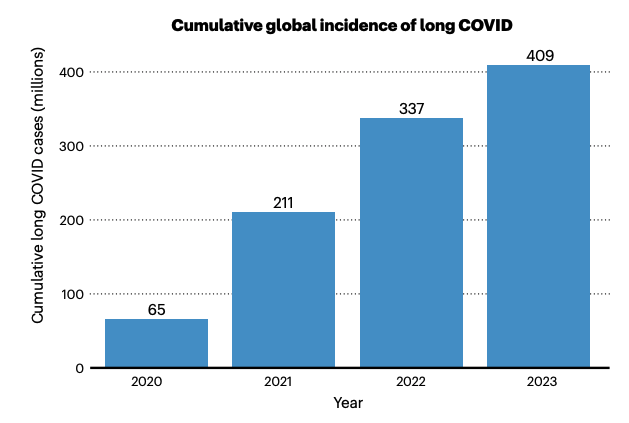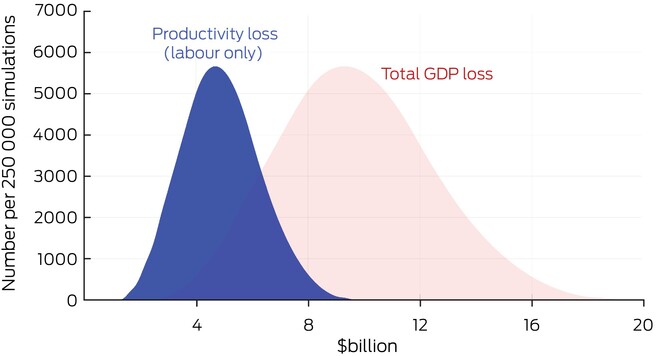Welcome to the 113th and final edition of the Research Digest for 2024. This edition highlights significant findings on the growing challenges of long COVID and its connection to ME/CFS. The featured articles delve into the global, social, and economic impacts of long COVID, explore opportunities for research and treatment, and underscore the urgent need for action to support those affected.
Contributing Digesters: Ryan and Simone.
New addition to the Research Digest!! In response to recent feedback from our community, we’ve introduced the Easy Read Overview. Placed before each article’s summary, the Easy Read Overview gives readers a short, two- to three-sentence overview, providing a quick snapshot of the research, making it even easier, to stay informed.
We hope you find the Easy Read Overview and the recently added audio summaries (below), valuable features of Emerge Australia’s Research Digest.
You can also join our community and choose to have the Digest delivered straight to your inbox at the end of every month, by signing up to our mailing list here. We appreciate the support of everyone who reads the Digest – we encourage regular subscribers to support us with a monthly suggested donation of $2.
Audio transcription powered by Aidocmaker.com
Long COVID science, research and policy
Authors: Al-Aly Z, Davis H, McCorkell L, Soares L, Wulf-Hanson S, Iwasaki A & Topol E (Scripps Institute, USA.)
Publication: Nature Medicine
Link: https://doi.org/10.1038/s41591-024-03173-6
Easy Read Overview: This review examines the global impact of long COVID, which affects millions of people and often leading to lifelong conditions like ME/CFS, creating significant economic and healthcare challenges. It highlights the complex biological mechanisms underlying the condition and emphasises the urgent need for more research, including clinical trials and biomarker identification. The authors also stress the importance of sustainable strategies to address long COVID and prepare for future pandemics.
This review presents an overview of the state of the science of long COVID and provides a roadmap for future research and policymaking.
Long COVID’s epidemiology is underpinned by a multitude of factors, including different risk rates amongst COVID variants and development or exacerbation upon reinfection of COVID-19. Whilst those with severe COVID-19 had a higher chance of developing long COVID, mild COVID-19 infections account for over 90% of those with long COVID. Importantly, only 7-10% recovered after two years, with many developing life-long conditions, ME/CFS among them.
Data from the US Centers of Disease Control & Prevention (CDC) show that 6.9% of US adults have experienced long-term COVID, and two to four million adults have been out of work due to their condition. In total, it is estimated that globally, long COVID affects 6-7% of the adult and 1% of the child population. It is projected that the annual global toll could amount to $1 trillion, or 1% of the global GDP in 2024.
The article provided an overview of the evidence of potential underlying mechanisms of the condition, including viral persistence, immune dysregulation, mitochondrial dysfunction, microbiome dysbiosis, neuroinflammation, microglial activation, hypothalamic-pituitary-adrenal axis dysregulation and thromboinflammation.
The article also highlighted the global burden of long COVID. The increased risk of developing non-communicable diseases, such as diabetes and heart disease, after SARS-CoV-2 infection places a major strain on healthcare systems. Long COVID’s large overarching effect could also exacerbate economic inequality and access to healthcare, delaying the ability to meet the UN’s Sustainable Development Goals.
In the absence of evidence-based protocols, assessment and treatment decisions have followed approaches used in related conditions, including ME/CFS, however, randomised clinical trials and longitudinal studies are sorely needed to provide a more thorough understanding of long COVID. Large-scale platform designs that can adaptively test a large array of drugs offer an exciting alternative to traditional clinical trial approaches. Additionally, identifying biomarkers is essential for both diagnosis and stratifying subtypes to ensure management approaches can be tailored to the individual. The authors also recommend that preparedness for future pandemics should focus on a sustainable and long-term solution that balances large-scale public health preventative action and individual-level care.
Figure. The estimated global cumulative incidence of long COVID by year.
Six-week Supplementation with creatine in myalgic encephalomyelitis/chronic fatigue syndrome (ME/CFS): A magnetic resonance spectroscopy feasibility study at 3 tesla
Authors: Godlewska BR, Sylvester AL, Emir UE, Sharpley A., Clarke WT, Martens MAG, & Cowen PJ. (University of Oxford, UK)
Publication: Nutrients
Link: https://www.mdpi.com/2072-6643/16/19/3308
Easy Read Overview: This study tested whether creatine supplements can improve brain function and symptoms in people with ME/CFS. Eleven participants took creatine daily for six weeks, and their brain creatine levels, fatigue, memory, and hand-grip strength were measured before and after treatment. Results showed increased brain creatine levels, reduced fatigue, faster reaction times, and improved memory and strength, suggesting creatine may help ME/CFS symptoms, though more research is needed.
Creatine is a nutrient molecule that aids in replenishing intracellular energy in the form of ATP and is essential in the energy-demanding brain tissue. Importantly, creatine also bolsters mitochondrial functioning, which is disrupted in ME/CFS. This study is the first to investigate the effects of oral creatine supplementation on brain creatine concentration and the relationship between brain creatine concentration and ME/CFS clinical symptoms.
Fourteen patients diagnosed with ME/CFS (Fukuda criteria) participated in the study. The regimen consisted of 16g of creatine monohydrate ingested orally daily for six weeks; the dosage and treatment length were chosen based on studies in other conditions, as they were deemed likely to increase brain creatine levels. Before starting and on the last day of supplementation, participants underwent magnetic resonance spectroscopy of two brain regions: the pregenual anterior cingulate cortex (pgACC) and the dorsolateral prefrontal cortex (DLPFC). The pgACC is understood to be integral to information association, and the DLPFC is responsible for executive functioning and working memory. Both regions are suspected to be compromised in ME/CFS. A hand-grip strength test, symptom ratings and cognitive function (reaction time, working memory, and inhibitory control) tests were also undertaken before and after treatment.
Of the 11 patients who completed the study, there was a significant increase in creatine levels in the pgACC and DLPFC. There was also a decrease in fatigue and reaction time, as well as improved recall and increased hand-grip strength. Among these, greater creatine levels in the pgACC and DLPFC correlated with reduced reaction time and improved recall, respectively. The findings are consistent with the sparse literature of creatine supplementation in long COVID and related diseases like fibromyalgia.
Although this study is limited by its small sample size and lack of a control group, the authors suggest that it serves as a precedent for future investigations into creatine and other notable regions of the brain.
Figure. (a) The relative placements of DLPFC (blue) and pgACC (green). (b) The spectra of neurometabolite concentration change (ppm). tCr = total creatine, NAA = N-acetylaspartate.
The public health and economic burden of long COVID in Australia, 2022–24: a modelling study
Authors: Costantino V, Grafton Q, Kompas T, Chu L, Honeyman D, Notaras A, MacIntyre, CR (The Kirby Institute, Australia).
Publication: The Medical Journal of Australia
Link: https://doi.org/10.5694/mja2.52400
Easy Read Overview: Current public health strategies focus on acute COVID-19 symptoms but often overlook long COVID’s long-term impacts. This study estimated long COVID’s prevalence in Australia, peaking at 1.2-5.4% of the population in September 2022, and its economic toll, with labour losses amounting to $4.8–$9.6 billion in 2022. The authors emphasised the need to prevent long COVID through vaccination, especially in working adults, and called for further research into antiviral treatments.
Current COVID-19 public health strategies focus primarily on the acute symptoms to mitigate hospitalisation and death, neglecting the impact of long COVID. This study uses hospitalisation and mortality data, along with serological surveys, to estimate the prevalence of long COVID and its national economic impact.
The data for the estimation is based on a serosurvey of Australian blood donors conducted by the Kirby Institute. The median age of adult donors was 44-47 years old, with four data points from early to late 2022. The presence of SARS-CoV-2 antibodies was then projected from January 2022 to December 2024, and the prevalence of long COVID was estimated.
Prevalence for long COVID amongst all Australians peaked at 1.2-5.4% in September 2022, and gradually declined to 0.7-3.4% of all Australians, by December 2024. Long COVID had the highest prevalence in those aged 35-49; the brunt of the disease burden landed on those of working age, which is the root of the profound economic impact.
The estimated labour lost to long COVID in 2022 was 102.4 million hours, equating to 8.0 hours lost per employed person. The projected economic loss from labour loss alone was $4.8 billion, or 0.2% of GDP; this figure rises to $9.6 billion, or 0.5% of GDP, when factoring in a proportional reduction in other factors of production. Noteworthy, the authors highlighted that their model does not account for losses caused by long COVID beyond six months, the rate of re-infection, and other indirect productivity losses. This suggests that the reported figures likely represent an underestimation.
The authors emphasised the urgency to take action to prevent long COVID, particularly by increasing access to and encouraging vaccinations in working adults, as it has been shown to reduce both the risk of contracting COVID and its symptoms. The authors also recommend further studies into the effectiveness of antiviral medication as another potential frontline treatment for long COVID.
Figure 1. The projected prevalence of people with long COVID symptoms from 2022-2024, split by age groups. The high and low estimates are produced by different long COVID rates to account for variability.
Figure 2. Simulated models of productivity loss in the Australian economy that is attributable to long COVID. The productivity loss curve (blue) is the lower range of the estimation as it assumes that other factors, such as infrastructure, are unaffected by the labor loss. The total GDP loss curve (pink) factors in related production that are affected by labor loss and is likely an overestimation.
Long COVID is becoming a serious social and economic issue for Australia
Authors: Murphy J
Publication: Crikey
Link: https://www.crikey.com.au/2024/12/02/long-covid-symptoms-viruses-health-labour-australia/
Long COVID is emerging as a significant social and economic issue in Australia. It affects up to 20% of individuals three months post-infection, including children and working-age adults. The condition disrupts lives through prolonged symptoms like fatigue, brain fog, and chronic pain, leading to lost earnings and increased disability rates. While vaccination and milder COVID variants like Omicron reduce risks, research suggests lingering viral presence may cause long-term effects. Understanding long COVID’s causes and potential treatments is crucial for recovery and reducing its societal burden.






